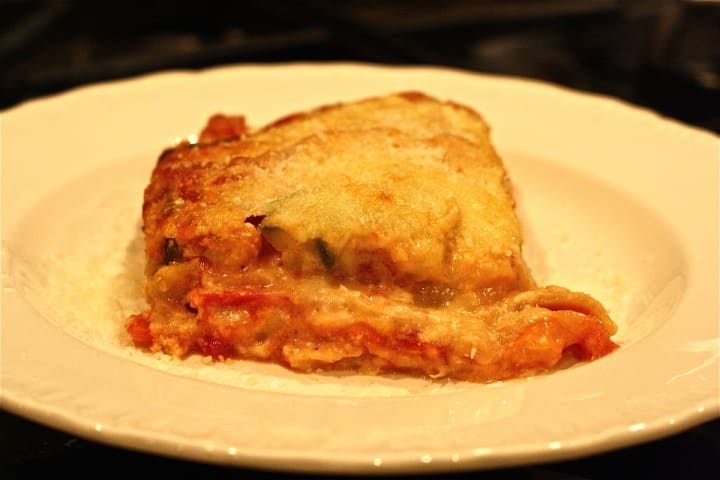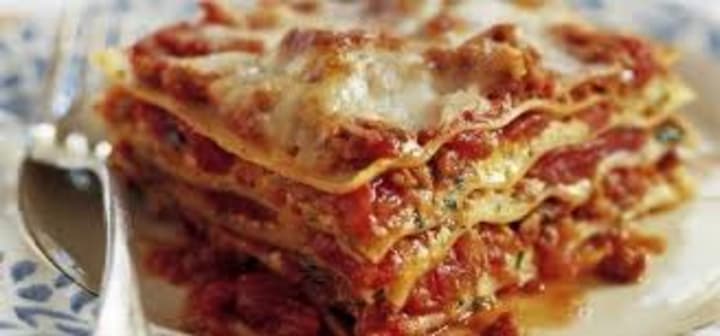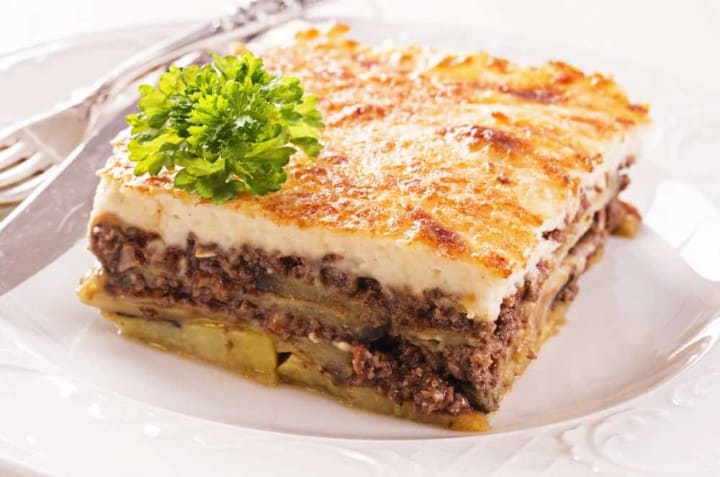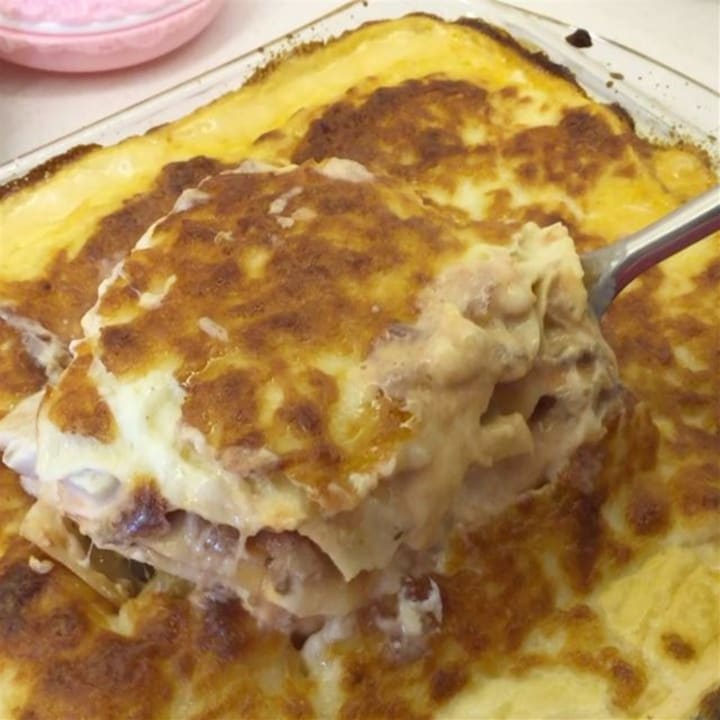The Story Of Lasagna
The Italian meal with real taste appeal

Lasagna is a delicious Italian meal however often people don't have the time to put it together and look toward take-out or frozen. No matter what when you do have the time the best thing is to put a lasagna together yourself and freeze the leftover pieces.
Origin
If you think the origins of lasagna can be found in Italy you'll be surprised to know that they go back all the way to Ancient Greece. The word lasagna is derived from "laganon" which were flat sheets of pasta dough cut into strips. The lasagna way back then consisted of pasta layers and sauce without any added traditional Italian ingredients. In ancient Rome, you could find a dish called lasanum meaning cooking pot in Latin and referred to the pot in which the meal was served. Eventually, with different cooking techniques, the meal became the lasagna we know today,
The Making of Lasagna
The favored Italian version of lasagna came from Naples, Italy in the Middle Ages. A reference to this meal can be first found in an English cookbook dating from the 14th century. However, this dish was a layer of pasta with no tomatoes and tomato sauce was added in the 1880s.

After some time the traditional lasagna in Naples evolved and was called Lasagna di Carnevale. It consisted of the local sausage, fried meatballs, hard-boiled eggs, ricotta or mozzarella and Neapolitan ragu. Of all the variation on this dish the most popular is Lasagna al Forno orginating from the Emilia-Romagna region of Italy. This version includes mozzarella or ricotta, thick Rgu, bechamel sauce, onion. oregano, wine, and sheets of spinach pasta. There are other variation found all through Italy like in Piedmont where it is Lasagna de Sangue and includes blood from a slaughtered pig.
Nutritional Benefits of Lasagna
Lasagna is a very good source of carbohydrates which help bring energy to blood cells. The carbohydrates help the body function normally. Most of this energy comes directly from the pasta and some from the sauce and vegetables added. Other nutrients include vitamins and minerals. Lasagna has plenty of vitamins to keep your body's metabolism up. The beef added to this recipe provides iron for healthy circulation of blood and Vitamins A and C from the vegetables like tomatoes.
Lasagna is also a good source of dietary protein and fat, The body breaks up the proteins into amino acids to create and maintain healthy tissues. Each ounce of the meats and cheeses provides between 6 to 7 grams of protein. Just don't overdo with these ingredients since they are also a source of saturated fats. There are healthy substitutions you can use like making your lasagna with wheat pasta which will stabilize your blood sugar levels. Add 50% lean ground beef, turkey, or chicken and drain off excess fat. Limit the amount of cheese you put into your lasagna and for more nutritional value add more vegetables for a healthy intake of vitamins, fibre, and minerals.
Lasagna is the greatest comfort food and it is best to make it at home. Even though putting together a lasagna takes time you can freeze the pieces left over for a future meal. If your significant other also enjoys cooking make lasagna together. As one person once said to me - "the family that makes lasagna together, stays together."
Variations On Lasagna
Italy

In Italy, the lasagna varies from region to region. The traditional type uses butter, flour, and milk bechamel or white sauce and no ricotta cheese. Making red sauce the homemade version has fresh pureed tomatoes. Other vegetables can be added as long as they're red such as red bell peppers. Adding meat to the lasagna it can be either Italian sausage or ground beef or even a combination of the two. Putting the meal together you get layers of pasta with meat and creamy white and red sauces topped with parmesan or grated mozzarella.
Spain

Making lasagna in Spain means adding a smoky texture with chorizo which is simmered with onions. Other kinds of meat used include chicken breast, ground beef, ground pork, pork liver pate and finely chopped bacon. It is possible to mix all of these meats together but if you don't want so much meat then choose either chicken breast or ground beef and if you're going with pork make it a combination with another meat so the dish won't be too sweet. You can also layer the pasta with seafood such as cod for a different taste treat and use bechamel or tomato sauce.
One variation takes a large bowl combining pork, minced onion, minced parsley, thyme, red pepper flakes, salt, black pepper, and minced garlic and refrigerate. In saucepan cook sliced mushrooms and garlic and add pureed tomatoes, red wine, and Italian seasonings. Bring to a boil and cook for an hour. You can add tomato paste to thicken. After cook up the pork. Then take a baking pan and layer the ingredients between sheets of pasta.
Portugal

The two things everyone loves in Portugal is seafood and hot food. The sauce will be marinara with tomatoes and browned meat using spicy BBQ type meats. Season with paprika, pepper, garlic and nutmeg. Making bechamel sauce add whipping cream instead of milk. For a seafood variation, use fleshy fish like cod or kingklip or hake then seasoned with salt, pepper, and parsley. Mussels and shrimp can be added and some recipes include boiled egg with the fish layers. And if you choose to male the lasagna with seafood it can be best to use only bechamel sauce.
Greece

In Greece, they have their own special kind of dish similar to lasagna because it is made in layers and that is moussaka. Usually, slow-roasted lamb is used. Spices include mint and parsley. Some chefs use pesto as a layer between the bechamel sauce. Moussaka also means no pasts layers instead, thin layers of eggplant and mashed potatoes. Some use only white sauce others combine white and red sauce.

Norway
In Norway think of seafood when you think of lasagna. Make use of such fish as haddock lightly simmered with onions and leeks and parsley. Bechamel sauce is used and sour cream is included as an extra layer between the creamy sauce and fish. The combination of flavors is fantastic.
Japan

Where pasta layers are excluded and seaweed layers have salmon or seared tuna and even flaky fish such as haddock or mackerel. Make use of teriyaki as a seafood marinade and other sauces like soy, oyster, and sesame seed. You can also choose to use teriyaki with just one other sauce. Make nice layers with the seaweed and fish.
Lebanon

Here the lasagna variation includes bechamel with Parmesan and the use of yogurt, tahini and feta or even sour cream along with vegetables, Usually, mushrooms are used and made into a bechamel sauce with sour cream. Besides mushrooms, you can include eggplant, zucchini, red onion, and tomato. If using meat then either lamb or ground beef. The cheese choice mostly feta.
South Africa

Lasagna versions will include sweet-savory flavors and smoky types. One of the ingredients is bacon as a base with chopped onions while browning, You can include ground beef and pork using pork banger sausages. Smoked paprika is added to the red sauce as well as Italian herbs, Worchester sauce and local chutney.
China

In China, the layers combine in both sweet and sour flavorings. This dish is mostly inspired by the Cantonese province. One of the things to do first is to marinate the chicken overnight, Use the marinade sauce to cook the meat, adding mustard, chili, and capsicums. When layering bok choy and Chinese spinach can be used as well,
Mexico

A lot of people enjoy Mexican dishes. Make your next lasagna Mexican by layering it with taco ingredients including soft taco shells for the layers and salsa. You can add different veggies like onions, and sweet peppers to your dish which will complement the spicy ground beef or you can include some spicy Mexican sausage along with grated Cheddar cheese or choose a Mexican type cheese.
About the Creator
Rasma Raisters
My passions are writing and creating poetry. I write for several sites online and have four themed blogs on Wordpress. Please follow me on Twitter.






Comments
There are no comments for this story
Be the first to respond and start the conversation.